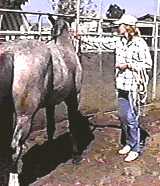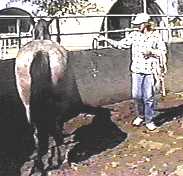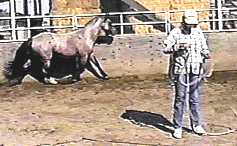Desensitizing "Bridle Shy" Horses
|
|
DON'T get into a fight when it comes time to bridle your horse. In most cases a struggle will merely increase your horse's anxiety when it comes time for bridling which will not only perpetuate the problem, but make it worse. This section offers a simple and painless way to help resolve this difficulty. The horse presented here is Dahlia, a 14 year old mustang / appaloosa cross who has a history of serious abuse. She is a sweet, bright mare who unfortunately displays numerous physical and emotional scars. Her present owners "rescued" her and are trying to develop her into a trustworthy trail horse. While ordinarily gentle, Dahlia suffers the most severe "panic attacks" we've ever seen when someone tries to handle her face, especially when approaching her with a bridle. Even the local veterinarian can't examine her face or mouth. Looking at the many scars across her nose, one can only imagine what occurred to make her this way. Our training objective is to desensitize her and "redirect" her emotions so that she can logically think about what's going on around her mouth instead of reacting in panic. The materials we use include a horseman's (hand tied rope) halter, a 12' kernmantle horse handling rope, a longe whip, a standard leather bridle with snaffle bit (adjusted to fit the horse) and a 40 foot round corral. Key Point:Using the right equipment has definite advantages. The rope halter facilitates very sensitive, but non injurious contact with the horse, the kernmantle horse handling rope has a good weight, length and feel and is "twist resistant", the longe whip is used only for "touching up" or reinforcing the other cues, and the round corral is necessary to let the horse work at liberty where she can exercise and improve her decision making skills. Before we approached her with the bridle we worked her in the round corral, getting her to respond well to longing cues. We wanted her to clearly understand our cues to send her off as well as to "draw" back into the center of the round corral when asked. This was the foundation which would support our other work. We worked her both off and on-line. As she started to get better at the longe, we would let her come in to the center for rest breaks whereupon we would face her and massage her neck, ears, jawbones and eventually her muzzle. It wasn't long before she would stand half-asleep while we gently handled her face. Key Point:When we were massaging her face, she was NEVER haltered or restrained. She could choose to leave at any time. When she left, we put her back to work. This was fine, too, since there were a number of things she needed to learn "on the longe" and we always try to make any negative reinforcement a useful activity. Thus the horse can make the choice to either "relax and learn" or to "work and learn". (Unless you have unlimited time with which to work with your horse, you have to make the most of your time which is why we like to set up "learn - learn" choices whenever we can.) It wasn't long before Dahlia decided that it was much more fun to stand and "enjoy" a face massage than to work at a trot. Once this work vs. acceptance relationship was established, we were ready to bring out the bridle for the next "lesson".
Key Point:Dahlia was still allowed to DECIDE on her own whether to stay or leave. She had to develop her thinking to the point that it would supersede her emotions and this could not be done if she was restrained in any way.
Key Point:
Most horses like to learn, so long as the trainer is not abusive and sets up the problems in a way the horse can actually "participate" through logical thinking and satisfying its natural curiosity. I can't remember a horse who didn't enjoy problem solving if things were set up correctly, and as they develop their problem solving skills, they all have become MUCH less reactive and spooky. Next Installment:Bridling Dahlia, where we teach her to accept it comfortablyPress "Back" to return to the page that brought you hereGo to Case Study SectionReturn to Training SectionReturn to Wild Horse MentorsReturn to KBR World of Wild Horses and BurrosGo To
|

 After a brief warmup in the round corral so that Sharon could assess
Dahlia's responsiveness and state of mind, she entered the round corral
holding the bridle. Dahlia panicked and raced wildly around for several
minutes while Sharon stood quietly in the center displaying the bridle
to the horse. Once she had grown tired of running, Sharon approached Dahlia with the
bridle. She started in the "neutral zone" (at the shoulder) and basically
rubbed the horse on the shoulder, back and neck with the bridle. Dahlia
was a little wary (her body language displayed reluctant acceptance at
first), but she stood still for this contact even though she was not restrained.
After a brief warmup in the round corral so that Sharon could assess
Dahlia's responsiveness and state of mind, she entered the round corral
holding the bridle. Dahlia panicked and raced wildly around for several
minutes while Sharon stood quietly in the center displaying the bridle
to the horse. Once she had grown tired of running, Sharon approached Dahlia with the
bridle. She started in the "neutral zone" (at the shoulder) and basically
rubbed the horse on the shoulder, back and neck with the bridle. Dahlia
was a little wary (her body language displayed reluctant acceptance at
first), but she stood still for this contact even though she was not restrained. Approaching her head with the bridle was tough on Dahlia. Anxiety welled
up, and although it was no longer a panic response, she could not tolerate
the presence of the bridle for more than a few seconds and would back away. (In proper
perspective, this was a marked improvement over her initial behavior, a change which
we had hoped to achieve and we were glad to see.) Since the horse was more deliberate and less
reactive in her actions, we could now send her off to longe each time she
backed away from the bridle and she could connect the association.
Approaching her head with the bridle was tough on Dahlia. Anxiety welled
up, and although it was no longer a panic response, she could not tolerate
the presence of the bridle for more than a few seconds and would back away. (In proper
perspective, this was a marked improvement over her initial behavior, a change which
we had hoped to achieve and we were glad to see.) Since the horse was more deliberate and less
reactive in her actions, we could now send her off to longe each time she
backed away from the bridle and she could connect the association. When she would back away, Sharon would immediately respond by cuing Dahlia
to trot a couple of circles. After two laps she would invite Dahlia back
in to the center to approach the bridle. After about a half dozen
repetitions, Dahlia was longing herself. When the situation got to be too
much for her, she would trot off and "take two" laps and return on her own
to face the bridle. She was starting to regain control of her emotions to
the point that she could think this situation through.
When she would back away, Sharon would immediately respond by cuing Dahlia
to trot a couple of circles. After two laps she would invite Dahlia back
in to the center to approach the bridle. After about a half dozen
repetitions, Dahlia was longing herself. When the situation got to be too
much for her, she would trot off and "take two" laps and return on her own
to face the bridle. She was starting to regain control of her emotions to
the point that she could think this situation through.